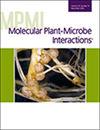求助PDF
{"title":"ZymoSoups: A High-Throughput Forward Genetics Method for Rapid Identification of Virulence Genes in <i>Zymoseptoria tritici</i>.","authors":"Haider Ali, Megan C McDonald, Graeme J Kettles","doi":"10.1094/MPMI-08-24-0082-TA","DOIUrl":null,"url":null,"abstract":"<p><p>Septoria tritici blotch is caused by the fungus <i>Zymoseptoria tritici</i> and poses a major threat to wheat productivity. There are over 20 mapped loci in wheat that confer strong (gene-for-gene) resistance against this pathogen, but the corresponding genes in <i>Z. tritici</i> that confer virulence against distinct <i>R</i> genes remain largely unknown. In this study, we developed a rapid forward genetics methodology to identify genes that enable <i>Z. tritici</i> to gain virulence on previously resistant wheat varieties. We used the known gene-for-gene interaction between <i>Stb6</i> and <i>AvrStb6</i> as a proof of concept that this method could quickly recover single candidate virulence genes. We subjected the avirulent <i>Z. tritici</i> strain IPO323, which carries the recognized <i>AvrStb6</i> allele, to ultraviolet (UV) mutagenesis and generated a library of over 66,000 surviving spores. We screened these survivors on leaves of the resistant wheat variety Cadenza in mixtures (soups) ranging from 100 to 500 survivors per soup. We identified five soups with a gain-of-virulence (GoV) phenotype relative to the IPO323 parental strain and re-sequenced 18 individual isolates, including four control isolates and two isolates lacking virulence, when screened individually. Of the 12 confirmed GoV isolates, one had a single nucleotide polymorphism (SNP) in the <i>AvrStb6</i> coding region. The other 11 GoV isolates exhibited large (approximately 70 kb) deletions at the end of chromosome 5, including the <i>AvrStb6</i> locus. Our findings demonstrate the efficiency of this forward genetic approach in elucidating the genetic basis of qualitative resistance to <i>Z. tritici</i> and the potential to rapidly identify other, currently unknown, <i>Avr</i> genes in this pathogen. [Formula: see text] Copyright © 2025 The Author(s). This is an open access article distributed under the CC BY-NC-ND 4.0 International license.</p>","PeriodicalId":19009,"journal":{"name":"Molecular Plant-microbe Interactions","volume":" ","pages":"226-234"},"PeriodicalIF":3.4000,"publicationDate":"2025-03-01","publicationTypes":"Journal Article","fieldsOfStudy":null,"isOpenAccess":false,"openAccessPdf":"","citationCount":"0","resultStr":null,"platform":"Semanticscholar","paperid":null,"PeriodicalName":"Molecular Plant-microbe Interactions","FirstCategoryId":"99","ListUrlMain":"https://doi.org/10.1094/MPMI-08-24-0082-TA","RegionNum":3,"RegionCategory":"生物学","ArticlePicture":[],"TitleCN":null,"AbstractTextCN":null,"PMCID":null,"EPubDate":"2025/1/24 0:00:00","PubModel":"Epub","JCR":"Q2","JCRName":"BIOCHEMISTRY & MOLECULAR BIOLOGY","Score":null,"Total":0}
引用次数: 0
引用
批量引用
Abstract
Septoria tritici blotch is caused by the fungus Zymoseptoria tritici and poses a major threat to wheat productivity. There are over 20 mapped loci in wheat that confer strong (gene-for-gene) resistance against this pathogen, but the corresponding genes in Z. tritici that confer virulence against distinct R genes remain largely unknown. In this study, we developed a rapid forward genetics methodology to identify genes that enable Z. tritici to gain virulence on previously resistant wheat varieties. We used the known gene-for-gene interaction between Stb6 and AvrStb6 as a proof of concept that this method could quickly recover single candidate virulence genes. We subjected the avirulent Z. tritici strain IPO323, which carries the recognized AvrStb6 allele, to ultraviolet (UV) mutagenesis and generated a library of over 66,000 surviving spores. We screened these survivors on leaves of the resistant wheat variety Cadenza in mixtures (soups) ranging from 100 to 500 survivors per soup. We identified five soups with a gain-of-virulence (GoV) phenotype relative to the IPO323 parental strain and re-sequenced 18 individual isolates, including four control isolates and two isolates lacking virulence, when screened individually. Of the 12 confirmed GoV isolates, one had a single nucleotide polymorphism (SNP) in the AvrStb6 coding region. The other 11 GoV isolates exhibited large (approximately 70 kb) deletions at the end of chromosome 5, including the AvrStb6 locus. Our findings demonstrate the efficiency of this forward genetic approach in elucidating the genetic basis of qualitative resistance to Z. tritici and the potential to rapidly identify other, currently unknown, Avr genes in this pathogen. [Formula: see text] Copyright © 2025 The Author(s). This is an open access article distributed under the CC BY-NC-ND 4.0 International license.
ZymoSoups:高通量正向遗传学方法,用于快速鉴定三尖杉球孢菌(Zymoseptoria tritici)的毒力基因。
三尖孢(Septoria tritici)斑点病是由三尖孢(Zymoseptoria tritici)真菌引起的,对小麦的产量构成重大威胁。小麦中有二十多个测绘位点能赋予小麦对该病原体的强抗性(基因对基因),但三尖孢(Z. tritici)中能赋予不同 R 基因毒力的相应基因在很大程度上仍不为人所知。在这项研究中,我们开发了一种快速的正向遗传学方法,以确定能使 Z. tritici 对以前具有抗性的小麦品种产生毒力的基因。我们利用 Stb6 和 AvrStb6 之间已知的基因间相互作用作为概念验证,证明这种方法可以快速恢复单个候选毒力基因。我们对携带被识别的 AvrStb6 等位基因的无毒三裂叶蝉菌株 IPO323 进行了紫外诱变,并生成了一个包含 66,000 多个突变体的文库。我们在抗性小麦品种 Cadenza 的叶片上对这些突变体进行了筛选,每种突变体的混合物(汤)的数量为 100-500 个。我们确定了相对于 IPO323 亲本菌株具有毒力增益(GoV)表型的 5 个汤剂,并对 18 个分离株进行了重测序,其中包括 4 个对照分离株和 2 个缺乏毒力的突变株。在 12 个确认的 GoV 突变体中,有一个在 AvrStb6 编码区存在单核苷酸多态性 (SNP)。其他 11 个 GoV 突变体在 5 号染色体末端(包括 AvrStb6 基因座)出现了较大(约 70Kb)的缺失。我们的研究结果表明,这种正向遗传方法能有效地阐明对三尖杉属蚜虫(Z. tritici)定性抗性的遗传基础,并有可能快速鉴定出该病原体中其他目前未知的 Avr 基因。
本文章由计算机程序翻译,如有差异,请以英文原文为准。

 求助内容:
求助内容: 应助结果提醒方式:
应助结果提醒方式:


